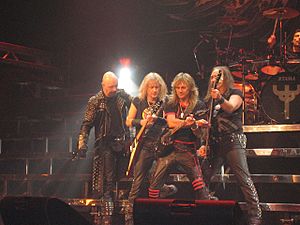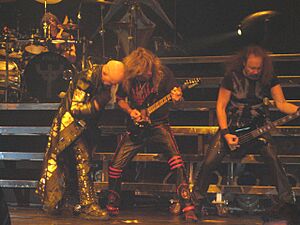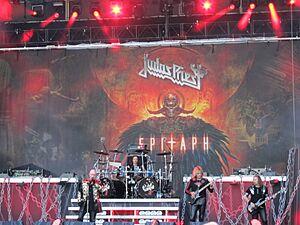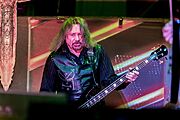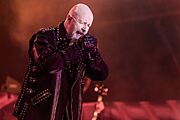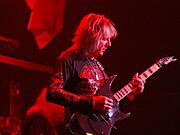Judas Priest facts for kids
Quick facts for kids
Judas Priest
|
|
|---|---|

Judas Priest at Wacken Open Air 2018
|
|
| Background information | |
| Origin | Birmingham, England |
| Genres | Heavy metal |
| Years active | 1969–present |
| Labels |
|
| Members |
|
| Past members |
|
Judas Priest is an English heavy metal band that started in Birmingham, England, in 1969. They have sold over 50 million albums worldwide. Many people consider them one of the greatest metal bands of all time. Judas Priest helped create a new style of British heavy metal. They also influenced many other metal styles like speed metal and thrash metal.
In the 1970s, the main members were bassist Ian Hill, singer Rob Halford, and guitarists Glenn Tipton and K. K. Downing. Drummers changed often until Dave Holland joined in 1979 for ten years. Since then, Scott Travis has been the drummer. Rob Halford left the band in 1992 but came back in 2003. K. K. Downing left in 2011 and was replaced by Richie Faulkner. The band's current members are Ian Hill, Glenn Tipton, Scott Travis, Rob Halford, and Richie Faulkner. Glenn Tipton still officially belongs to the band, but he tours less because of Parkinson's disease. Andy Sneap often fills in for him on tour. Ian Hill and Glenn Tipton are the only members who have played on every album.
Rob Halford's powerful singing and the two guitarists' unique sound inspired many bands. Their look, with leather and spikes, became very popular in the 1980s. Their album British Steel is often called a defining album for heavy metal music. Even after a quiet period in the 1990s, the band became popular again. They went on world tours, were honored at VH1 Rock Honors in 2006, and won a Grammy Award in 2010. Their songs have also been in video games like Guitar Hero and Rock Band. In 2022, Judas Priest joined the Rock and Roll Hall of Fame.
Contents
- Band History
- Early Days (1969–1974)
- Rocka Rolla Album (1974–1975)
- Sad Wings of Destiny (1975–1977)
- New Albums and Success (1977–1979)
- Rise to Fame (1979–1991)
- Halford Leaves and Returns (1991–2003)
- Reunion and New Music (2003–2006)
- Nostradamus Album (2006–2010)
- K. K. Downing Leaves and Farewell Tour (2010–2011)
- Redeemer of Souls (2011–2015)
- Firepower and Tipton's Health (2015–2019)
- 50th Anniversary and Invincible Shield (2019–2024)
- Future Plans (2024–Present)
- Band's Style
- Band's Impact
- Band Members
- Discography
- Tours
- See also
Band History
Early Days (1969–1974)
Judas Priest began in 1969 in Birmingham, England. The first members were singer Al Atkins, bassist Brian "Bruno" Stapenhill, guitarist John Perry, and drummer John "Fezza" Partridge. The name Judas Priest came from a Bob Dylan song called "The Ballad of Frankie Lee and Judas Priest".
The band recorded a demo and almost got a record deal, but the company closed. Al Atkins then joined a band called Freight, which included K. K. Downing on guitar, Ian Hill on bass, and John Ellis on drums. They decided to use the name Judas Priest. Their first show was in March 1971. Drummers changed a few times, and they started playing their own songs.
Al Atkins left the band in 1973. Soon after, drummer John Hinch and singer Rob Halford joined. Halford and Hinch played their first show with the band in May 1973. Judas Priest toured Europe in early 1974. When they returned to England, they signed a record deal with Gull. The record company suggested adding another guitarist, so Glenn Tipton joined the band.
Rocka Rolla Album (1974–1975)
Judas Priest recorded their first album, Rocka Rolla, in the summer of 1974. It was produced by Rodger Bain, who had worked with Black Sabbath. The album came out in September 1974. It had different music styles, from rock to heavy riffs.
There were some problems during recording, which made the sound quality not as good. The producer also decided not to include some popular songs the band played live. The tour for Rocka Rolla was their first international tour, with shows in Germany and Norway. The album did not sell well, and the band faced money problems.
Sad Wings of Destiny (1975–1977)
In 1975, Judas Priest played songs from their upcoming album on TV. Drummer John Hinch left and Alan Moore returned to the band. Money was still tight, and band members often ate only one meal a day while recording their next album. They wanted to mix rock with a more complex style.
The band recorded Sad Wings of Destiny in late 1975. The album cover shows an angel with a devil's cross, which became the band's symbol. It was released in March 1976. At first, the album did not sell much, but fans and critics now see it as the album where Judas Priest found their unique sound. It has heavy guitar riffs and complex song structures.
The band was not happy with Gull Records. Alan Moore left the band again. Sad Wings of Destiny caught the attention of CBS Records. With a new manager, the band signed with CBS and got more money for their next album. This meant Gull Records kept the rights to their first two albums.
New Albums and Success (1977–1979)
Judas Priest recorded their first album with a major label, Sin After Sin, in early 1977. Deep Purple bassist Roger Glover produced it. Alan Moore left during the recording, and Simon Phillips played drums for the album. This album helped develop heavy metal drumming with its use of double-kick drums. It also included a cover of Joan Baez's song "Diamonds & Rust".
Sin After Sin was released in April 1977. It was the first of many Judas Priest albums to sell enough copies to be certified Gold or Platinum. Simon Phillips did not want to join permanently, so the band hired Les Binks as their new drummer. With Les Binks, they recorded Stained Class (1978) and Killing Machine (1978), which was called Hell Bent for Leather in America. Les Binks was a skilled drummer and helped make the band's sound even better. He also played on Unleashed in the East (1979), a live album recorded in Japan. Around this time, the band started wearing their famous leather-and-studs outfits.
Rise to Fame (1979–1991)
After Killing Machine, the live album Unleashed in the East was released in 1979. It was the first of their albums to go platinum. The band's music became even heavier during this time.
Les Binks left the band in 1979. He was replaced by Dave Holland. With this new lineup, Judas Priest recorded six studio albums and one live album, achieving different levels of success.
In 1980, the band released British Steel. The songs were shorter and more radio-friendly but still had a heavy metal feel. Songs like "Breaking the Law" and "Living After Midnight" were played often on the radio. Their next album, Point of Entry (1981), followed a similar style.
The 1982 album Screaming for Vengeance had a big radio hit in the US called "You've Got Another Thing Comin'" This album sold very well, becoming Double Platinum. In May 1983, the band played at the US Festival in California, sharing the stage with other big metal bands.
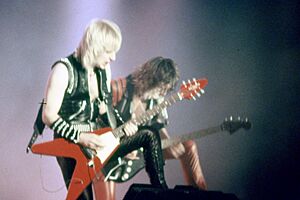
Judas Priest continued their success in the mid-1980s. Their song "Freewheel Burning" (1983) was popular on rock radio. The album Defenders of the Faith came out in 1984. On July 13, 1985, Judas Priest played at Live Aid in Philadelphia, a huge concert for charity.
Turbo was released in April 1986. The band used more colorful stage outfits and added guitar synthesizers to their music, giving it a more mainstream sound. This album also went Platinum. A live album from the tour, Priest...Live!, was released the next year.
In May 1988, Ram It Down was released. This album tried to go back to their traditional metal sound. In 1989, longtime drummer Dave Holland left the band.
In September 1990, the album Painkiller came out with a new drummer, Scott Travis. He brought a harder sound with his double bass drumming. This album also used fewer synthesizers. The tour for Painkiller included big bands like Megadeth and Pantera. It ended with a huge show at Rock in Rio in Brazil, playing for over 100,000 fans.
A famous part of Judas Priest's stage show was Rob Halford riding a Harley-Davidson motorbike onto the stage. In August 1991, during a show in Toronto, Halford had an accident when he rode into a drum set hidden by smoke. He was hurt but still finished the show before going to the hospital.
Halford Leaves and Returns (1991–2003)
After the Painkiller tour ended in 1991, there were some disagreements within the band. Rob Halford started a new band called Fight to try different music styles. He officially left Judas Priest in May 1992.
The remaining members of Judas Priest looked for a new singer for several years. In 1996, they hired Tim "Ripper" Owens, who had sung in a Judas Priest tribute band. This lineup released two studio albums: Jugulator in 1997 and Demolition in 2001. These albums had a different, more modern metal sound. They also released two live albums.
In 1998, Rob Halford shared publicly that he is gay.
Reunion and New Music (2003–2006)
After eleven years apart, Judas Priest and Rob Halford announced they would reunite in July 2003. They toured Europe in 2004 and co-headlined the Ozzfest festival in the US. Tim "Ripper" Owens left the band on good terms and joined another band.
A new studio album, Angel of Retribution, was released in March 2005. It was a success with critics and fans. The band then went on a world tour to support the album.
In May 2006, Judas Priest was honored at the "VH1 Rock Honors" event in Las Vegas. Other bands played a medley of their songs, and then Judas Priest performed some of their hits. Rob Halford rode his Harley-Davidson motorcycle onto the stage during their performance.
Nostradamus Album (2006–2010)
In 2006, Rob Halford mentioned that the band was working on a concept album about Nostradamus, a famous 16th-century writer. Halford said the album would have a lot of depth and might include symphonic elements and choirs. The album Nostradamus was released in June 2008, and the band started a tour to support it.
In 2009, Judas Priest toured with other bands like Megadeth and Testament in Europe. From June to August 2009, they toured North America to celebrate the 30th anniversary of British Steel. They played the entire album at each show.
In July 2009, Judas Priest released a new live album called A Touch of Evil: Live. One of the songs from this album, "Dissident Aggressor", won a Grammy Award in 2010.
K. K. Downing Leaves and Farewell Tour (2010–2011)
On December 7, 2010, Judas Priest announced that their Epitaph World Tour would be their last major world tour. Rob Halford said it was time for the band to say farewell, but also to celebrate their achievements.
On January 27, 2011, the band clarified that this was not the end of the band, and they were writing new music. Glenn Tipton said the new songs would have a lot of feeling and pay tribute to their fans.
On April 20, 2011, it was announced that K. K. Downing had retired from the band. He mentioned disagreements with the band and management. Richie Faulkner was announced as his replacement for the tour. Ian Hill became the longest-serving member of the band.
On May 25, 2011, Judas Priest performed on the finale of American Idol with singer James Durbin. This was their first live show without K.K. Downing.
Redeemer of Souls (2011–2015)
In August 2011, Rob Halford said that he and Glenn Tipton had many new songs ready for a new album. The band decided to take their time with the album to make sure it was perfect.
On September 13, 2011, Priest announced a new collection album called The Chosen Few. This album featured Judas Priest songs chosen by other famous heavy metal musicians.
On June 5, 2013, Halford confirmed that the Epitaph World Tour would not be the band's final tour after all. In December, they announced that their next album would be released in 2014.
On March 17, 2014, Halford announced that the band's 17th studio album was finished. The album's title track, "Redeemer of Souls", was released for streaming in April. Redeemer of Souls was released on July 8, 2014. It was the band's highest-charting album in the US, reaching No. 6 on the Billboard 200 chart. The band toured to support the album from October 2014 to December 2015. This tour led to their sixth live album, Battle Cry, released in March 2016.
Firepower and Tipton's Health (2015–2019)

In November 2015, Richie Faulkner said the band would start working on their 18th studio album in 2016. In April 2016, photos showed Rob Halford, Glenn Tipton, and Richie Faulkner in the studio. Halford confirmed the album would be ready by early 2017.
In March 2017, the band began recording with producer Tom Allom and guitarist Andy Sneap. This was the first time they worked with Allom since 1988. Halford said the album was almost finished and promised an exciting world tour in 2018.
The 18th album, Firepower, was released on March 9, 2018. A world tour followed, starting in North America.
On February 12, 2018, Glenn Tipton announced that he had Parkinson's disease and would not be able to tour as much. He said he was still a member of the band and might still perform sometimes. Andy Sneap took his place on tour. Richie Faulkner told fans that Tipton would still join the band on stage at some point. Tipton did join the band for some songs during encores on the Firepower World Tour.
50th Anniversary and Invincible Shield (2019–2024)
In March 2019, Rob Halford said a new studio album would be coming soon. Ian Hill mentioned that the band had strong ideas left over from Firepower. Richie Faulkner confirmed that Glenn Tipton would still be involved in making the new record.
Writing sessions for the new album began in February 2020. Andy Sneap and Tom Allom returned to help produce it. Rob Halford said Glenn Tipton contributed ideas, describing the new songs as "monsters."
Judas Priest planned a 50th-anniversary tour in 2020, but it was postponed due to the COVID-19 pandemic. They returned to the stage on August 15, 2021, at the Bloodstock Open Air festival, with Glenn Tipton joining them for the encore. The rest of the US tour was postponed because Richie Faulkner had a serious heart condition. It was rescheduled for spring 2022.
On April 29, 2021, former drummer John Hinch passed away at age 73. Rob Halford said the band had "a bunch of great new ideas for tracks." Ian Hill thought there was enough material for one or two albums.
In January 2022, Judas Priest announced that Andy Sneap would leave the touring lineup, but they quickly changed their minds, and he was reinstated. The band members said the new album would be different from Firepower. Glenn Tipton promised it would be "what every Priest fan will want." The album was fully written, but still needed to be recorded. Halford confirmed it would be released in 2024.
On November 5, 2022, Judas Priest was inducted into the Rock and Roll Hall of Fame. Former members K.K. Downing, Les Binks, and Dave Holland were also honored. The band performed three songs with Downing and Binks on stage.
Before their performance at the Power Trip festival on October 7, 2023, the band announced their next album, Invincible Shield, which was released on March 8, 2024. The first single, "Panic Attack", was available on October 13. Other singles like "Trial by Fire", "Crown of Horns", and "The Serpent and the King" followed.
Future Plans (2024–Present)
In February 2024, Richie Faulkner was asked if Judas Priest would make more albums. He said that after finishing an album, he feels like he has no more ideas, but new riffs and melodies always come later. He added, "You never know what the future holds." Rob Halford said that another album is "inevitable."
In October 2024, Faulkner was asked about touring in 2025 or recording a new album. He replied that there would likely be more touring, and the band always has new ideas. He hoped they could gather those ideas and possibly record something new.
In March 2025, Faulkner said the band had started talking about the next album. Both he and drummer Scott Travis hoped to begin working on it in 2026. On March 15, 2025, former drummer Les Binks passed away at age 73.
Band's Style
Music and Influences
Judas Priest's music has always been rooted in heavy metal. Their first album, Rocka Rolla (1974), had a heavy blues rock sound. From Sad Wings of Destiny (1976) to Stained Class (1978), their style was more complex, with detailed guitar parts and poetic lyrics. Their songs often changed in speed and feeling, and their music was very heavy for its time. This style later influenced progressive metal bands.
Starting with Killing Machine (1978), the band began to make their music more commercial and radio-friendly. British Steel is seen as the album that truly defined heavy metal. The lyrics and music became simpler. This style continued with Point of Entry (1981). With Screaming for Vengeance (1982), the band found a balance between these two styles. This continued on Defenders of the Faith (1984).
On Turbo (1986), the band added guitar synthesizers to their sound. Ram It Down (1988) kept some commercial qualities but also returned to the fast heavy metal of their earlier work. This fast style continued with Painkiller (1990).
After Rob Halford returned, the band went back to the style of their early albums with Angel of Retribution and Nostradamus. The band's popularity and influence have earned them the nickname "Metal Gods," from their song of the same name.
Rob Halford was influenced by singers like Little Richard and Elvis Presley. He developed a powerful, operatic singing style with a wide range, from low growls to high screams.
Fashion Style
Judas Priest is also known for changing heavy metal fashion. In their early years, they wore hippie-style clothes. But as the 1970s ended, they started wearing simpler outfits. For their 1979 tour, Rob Halford began wearing his famous leather-and-studs look. The rest of the band soon adopted a similar style. This look became very popular among heavy metal bands in the early 1980s. Even today, many metal artists and fans wear similar outfits at concerts.
K. K. Downing said he came up with the band's black-leather look. He felt the band needed a stronger image. He explained that the leather and studs completed their look, and "Heavy Metal was born."
Band's Impact
Judas Priest has had a huge influence on metal music since the late 1970s. MTV ranked them as the second "Greatest Metal Band" of all time, after Black Sabbath. VH1 named them the 78th greatest artist of all time in 2010.
The band has sold over 50 million records. In the United Kingdom, they have had 11 albums reach the top 30. In the United States, 11 of their albums have been certified gold or platinum, starting with Sin After Sin in 1977.
Many metal bands have named themselves after classic Judas Priest songs and albums, such as Sinner, Exciter, and Running Wild.
Judas Priest has influenced many thrash metal and speed metal bands. These include bands like Metallica, Megadeth, Slayer, and Pantera.
Band Members
Current members
- Ian Hill – bass, occasional backing vocals (1970–1992, 1996–present)
- Rob Halford – lead vocals (1973–1992, 2003–present)
- Glenn Tipton – guitars, backing vocals, keyboards (1974–1992, 1996–present)
- Scott Travis – drums, occasional backing vocals (1989–1992, 1996–present)
- Richie Faulkner – guitars, backing vocals (2011–present)
Current touring/session musicians
- Andy Sneap – guitars, backing vocals (2018–2022, 2022–present)
- Timeline
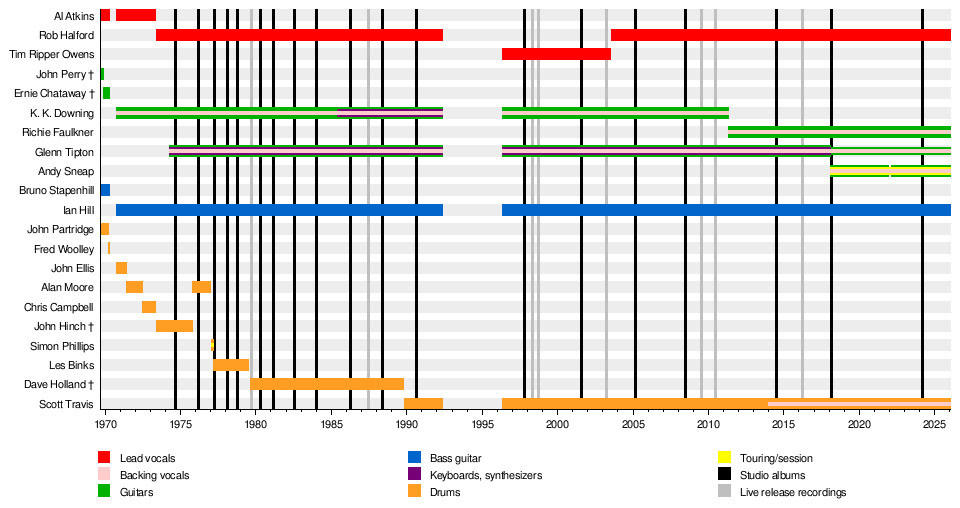
Discography
Studio albums
- Rocka Rolla (1974)
- Sad Wings of Destiny (1976)
- Sin After Sin (1977)
- Stained Class (1978)
- Killing Machine (1978)
- British Steel (1980)
- Point of Entry (1981)
- Screaming for Vengeance (1982)
- Defenders of the Faith (1984)
- Turbo (1986)
- Ram It Down (1988)
- Painkiller (1990)
- Jugulator (1997)
- Demolition (2001)
- Angel of Retribution (2005)
- Nostradamus (2008)
- Redeemer of Souls (2014)
- Firepower (2018)
- Invincible Shield (2024)
Tours
- Rocka Rolla Tour (1974–1975)
- Sad Wings of Destiny Tour (1976)
- Sin After Sin Tour (1977)
- Stained Class Tour (1978)
- Hell Bent For Leather Tour (1979)
- British Steel Tour (1980)
- World Wide Blitz Tour (1981)
- World Vengeance Tour (1982–1983)
- Metal Conqueror Tour (1984)
- Fuel for Life Tour (1986)
- Mercenaries of Metal Tour (1988)
- Painkiller Tour (1990–1991)
- Operation Rock & Roll (1991)
- Jugulator/'98 Live Meltdown Tour (1998)
- Demolition Tour (2001–2002)
- Reunited Tour (2004)
- Ozzfest (2004)
- Retribution Tour (2005)
- Metal Masters Tour (2008)
- Nostradamus World Tour (2008–2009)
- Epitaph/Farewell Tour (2011–2012)
- Redeemer of Souls Tour (2014–2015)
- Firepower World Tour (2018–2019)
- 50 Heavy Metal Years Tour (2021–2022)
- Invincible Shield Tour (2024–2025)
- Shield of Pain Tour (2025)
See also
 In Spanish: Judas Priest para niños
In Spanish: Judas Priest para niños



